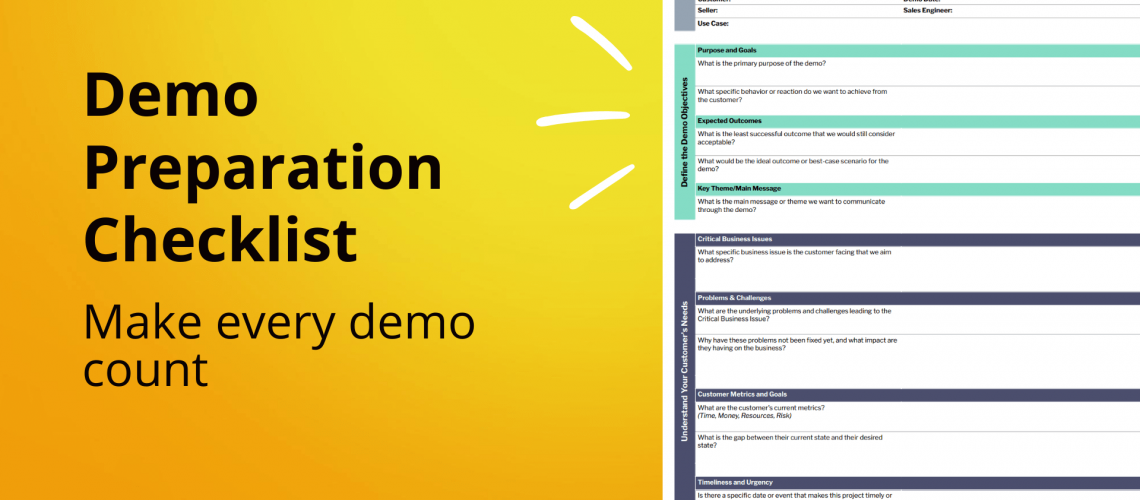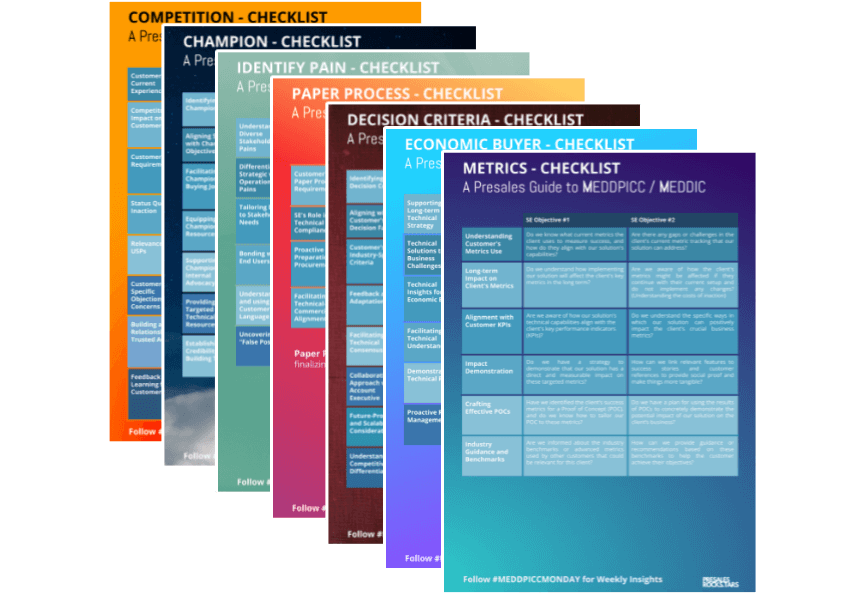No More ‘Show Up and Throw Up’ – How to Use a Product Demo Checklist to Deliver Demos That Win Deals
If you have ever sat through (or given) a product demo that felt like it was running on auto-pilot, you know the problem.
The salesperson or solution engineer clicks through feature after feature. The customer listens politely. Nobody is excited. Nobody is fully engaged. And at the end, nobody is quite sure what just happened – or why.
This is what I call the “show up and throw up” demo.
It is not that the product is bad. In fact, most of the time, the product is excellent. The problem is that there was no preparation, no alignment, and no clear objective.
The result?
A room (or Zoom call) full of people, but no real connection.

This is where a product demo checklist changes everything. It forces you to prepare, to get aligned, and to make the demo matter to your customer.
Why So Many Product Demos Fail
A bad demo often happens before the first slide even appears. It starts with missing discovery, unclear goals, and no shared understanding between the account executive and the solution engineer.
When that happens, the demo turns into a random tour of the product. You throw features at the customer, hoping something sticks. Sometimes you get lucky. Most times, you do not.
I have been on both sides – selling and buying software – and I have seen it happen when there is simply no plan. But even if you have very little information about the customer, you can still deliver value. You just need to align on a purpose and follow a preparation process.
That is where the product demo checklist comes in.

Mini-Checklist: Common reasons demos fail
- No single key takeaway for the customer
- No clear goal for the meeting
- Seller and SE are not aligned
- Discovery is incomplete or missing
- Demo flow is generic, not tailored
Internal Alignment – Non-Negotiable in Your Product Demo Checklist
Before we talk about customers, slides, or demo environments, let’s be clear on one thing:
If there is no internal alignment, there is no demo.
I am not exaggerating.
If the sales team cannot explain why this demo matters in terms of moving the opportunity forward, you do not give them your time. Demo resources are too valuable to waste on a “let’s just show them what we have” meeting.
Internal alignment is where your product demo checklist starts.
It is the agreement between the AE and SE on three things:
- Purpose & Goals – Why are we doing this demo? What is the “win” for this meeting?
- Expected Outcomes – What does success look like, both minimum and best case?
- Core Message – What single idea do we want the customer to remember and repeat?
If you skip this step, you are working blind.
You will show features with no context, the customer will leave without a clear takeaway, and you will have no way to measure whether the meeting moved the deal forward.
I have seen what happens when you ignore this. The AE says, “Let’s just give them an overview,” which is code for “I have no plan.” The SE prepares a generic tour, the customer sits politely, and we walk away with nothing but a calendar entry marked “completed.”
When you do it right, internal alignment turns the demo into a coordinated effort. Everyone knows the objective, the outcome, and the message — so the entire meeting is aimed at creating momentum in the deal.

See product demo entry and exit criteria for more insights.
Internal Alignment Checklist – Non-Negotiable
- AE and SE have agreed on the purpose of the demo
- Minimum and best-case outcomes are clear
- One key message is defined and tied to the customer’s biggest problem or goal
- Everyone understands what success looks like and how it will be measured
- No alignment = no demo
Step 1 – Purpose & Goals
Before you even open your demo environment, stop and ask:
Why are we here?
It sounds obvious, but I’ve been in too many demos where no one in the meeting could answer that clearly — not the AE, not the SE, and definitely not the customer.
Here’s what happens when there’s no clear purpose:
You jump straight into the product, start showing features you think are cool, the customer nods politely, and 45 minutes later… nothing. No energy. No momentum. No next step.
That’s why the product demo checklist starts with defining the purpose and goals.
This isn’t about “show the product.” It’s about agreeing on the reason for showing it.
Your purpose could be:
- Create urgency by showing the cost of doing nothing
- Get access to a decision maker or technical lead
- Validate technical feasibility to move to a proof of concept
- Confirm you’re on their shortlist before an RFP
When you know the purpose, you stop showing random features and start showing the right ones.
I tell teams in my workshops: If you can’t explain your demo’s purpose in one sentence, you’re not ready to give it.
Checklist for Purpose & Goals
- “Win” for this meeting is crystal clear
- Purpose agreed internally
- Desired customer action defined (e.g., schedule next meeting, bring in new stakeholder)
Step 2 – Expected Outcomes
Once you know why you are doing the demo, the next step in the product demo checklist is deciding what success looks like.
I always break this into two levels:
- Minimum success – the smallest win you would still be happy with
- Best case – the dream outcome you are aiming for
Why both? Because demos rarely go exactly as planned. If you only have a best case in mind, you risk leaving the meeting feeling like you have failed, even if you have actually moved the deal forward.
Good example:
- Minimum success: Customer agrees to bring in their compliance officer for a follow-up session
- Best case: Customer sets a date for a proof of concept to start next month
Bad example:
- Goal: “Show the product”
That is not an outcome, that is an activity. You can show the product for an hour and still end up with nothing.
Another bad example I have seen in the wild:
- Goal: “Get them excited”
Nice in theory, but too vague. Excitement without a clear next step is just entertainment.
And here is the simple truth:
If you have no goal in mind, you cannot measure success. You will leave the meeting with no idea whether it was worth the time, and so will the customer.
Why this matters:
When the team is clear on both minimum and best case, you can pivot in real time. If the conversation is not moving toward the dream outcome, you can aim for your minimum win and keep the momentum.
Checklist – Expected Outcomes
- Outcome is measurable (not vague like “make them excited”)
- Minimum success goal defined
- Best case goal defined
- Everyone on the internal team knows both
Step 3 – Core Message
Every strong product demo checklist includes one simple but powerful question:
What is the single key message we want the customer to remember after this demo?
Think about it from their side. After the call, someone will ask them,
“So, what did you think?”
If they cannot answer that in one short, confident sentence, your message was not clear enough.
Good examples of a core message:
- “They can help us cut compliance preparation time by 50 percent.”
- “Their system integrates with our existing tools without extra cost.”
- “If we do nothing, we will keep losing €350k every year in penalties.”
Bad examples of a core message:
- “They have a lot of features.”
- “It looked nice.”
- “They are one of the market leaders.”
Why these are bad: they are generic and forgettable. Anyone could say them about any vendor. They do not connect directly to the customer’s pain points or goals.
A clear core message is:
- Short and repeatable
- Linked to the customer’s biggest problem or goal
- Reinforced at the start, middle, and end of the demo
If you do not decide this upfront, you will end up showing interesting things that never connect to a bigger story. And the customer will remember random details instead of the reason they should buy from you.
Checklist – Core Message
- Reinforced multiple times during the demo
- Single key message defined and agreed internally
- Message is linked to customer’s specific problem or goal
- Easy to repeat in one sentence
Getting these three pieces right – purpose, outcomes, and core message – is non-negotiable.
It is the foundation of your product demo checklist and the filter for deciding what goes into the demo.
If you skip it, you are just showing up and hoping for the best.
If you do it, you start the meeting knowing exactly where you want to take the customer and how you will get there.
Step 4 – Capture Your Customer’s Situation and Identify Blind Spots
Up to now, the product demo checklist has been about internal alignment, making sure your team knows the purpose, desired outcomes, and key message before stepping into the room.
Now we turn the lens toward the customer.
Because if you do not deeply understand their situation, your demo becomes guesswork. And guesswork leads to generic, forgettable meetings.
This part of the checklist is about getting a clear, structured view of four things: the business issue, the problems and challenges, the metrics and goals, and the gap between where they are and where they want to be.
1. Business Issue
Ask yourself: What is the specific business problem the customer needs to solve?
It should be tangible and urgent enough to warrant change.
Examples:
- They are losing a significant percentage of market share
- They face €350k in penalties for missed audits
A good business issue is specific and measurable. “They need more ideas” is not enough — it does not justify investment or urgency.
2. Problems & Challenges
Next, identify the underlying obstacles stopping them from fixing this issue.
These are the pain points that will connect your demo to their reality.
Examples:
- Manual processes cause errors and lost records
- Missing documents delay audits
- Approvals are fragmented across tools and people
When you understand these challenges, you can choose features that directly remove or reduce them — instead of showing generic capabilities.
3. Metrics & Goals
Know how the customer measures success today and how they will measure improvement in the future.
Examples:
- Compliance preparation time
- Number and cost of penalties
If you can show in your demo how your solution moves these numbers in the right direction, you instantly prove relevance.
4. Gap
Finally, define the gap between their current state and the desired state.
Example:
- Ensure zero audit penalties and reduce compliance preparation time by 50 percent
The gap gives your demo a clear “before and after” story. Without it, you are simply showing what your product does, not what it changes.
Checklist – Customer Situation
- Business issue is clearly defined and specific
- Problems and challenges are understood
- Current metrics and goals are documented
- Gap between current and desired state is clear
Step 5 – Align Capabilities and Needs
Once you understand the customer’s situation, the next part of the product demo checklist is to connect the dots between their problems and your capabilities.
This is where many demos fall apart.
The team has great discovery notes but then jumps into a feature tour that ignores most of them. The result: the customer can’t see the link between their needs and what’s being shown.
Your job here is simple:
For every key challenge you identified, decide which feature, workflow, or capability directly addresses it and how you will demonstrate that in a way the customer will understand and care about.
1. Map Features to Problems
Take each challenge from your discovery and match it to a relevant capability.
Examples:
- Fragmented approvals across systems → Orchestration to unify approvals in tools like Salesforce and Coupa
- Lost records and delays → Error-free document management through standardised processes
- Slow cross-team coordination → Real-time triggers to align people and systems seamlessly
2. Focus on Benefits, Not Just Functions
Customers don’t buy “real-time triggers.” They buy faster decision-making and fewer delays.
Always phrase your points in business terms, not just technical descriptions.
3. Keep It Selective
This is not the time to show every single thing your product can do. Show the capabilities that make the biggest difference to this customer, right now.
Checklist – Align Capabilities & Needs
- Every key problem is matched with a relevant capability
- Benefits are explained in business terms
- Demo flow prioritises what matters most to the customer
Step 6 – Timeline and Urgency
Even the best demo can stall if the customer has no reason to act soon.
That’s why the product demo checklist always includes a step to confirm why now.
When you understand the customer’s timeline and the events driving it, you can position your solution as the answer to an immediate need — not a “maybe later” project.
1. Identify Trigger Events
Ask what deadlines, audits, renewals, or strategic projects are influencing their decision.
Examples:
- An upcoming audit at the end of Q1 2025
- Regulatory changes coming into effect next quarter
- A major product launch that depends on new processes being in place
2. Link Demo Content to Urgency
If you know an audit is looming, highlight features that reduce preparation time.
If a product launch is coming, focus on capabilities that remove bottlenecks.
3. Use Urgency to Secure Next Steps
The timeline should not just be “nice to know.” It should guide your close.
Example: “If we want to be ready for your audit in March, we need to start implementation in January. That means we should confirm the pilot by mid-December.”
Checklist – Timeline & Urgency
- Trigger events are identified
- Demo content connects directly to those events
- Next steps are tied to the customer’s timeline
Step 7 – Attendees
The last step in the pre-demo section of the product demo checklist is knowing exactly who will be in the room — and adjusting your approach for them.
Different roles care about different outcomes. If you pitch to everyone in the same way, you risk half the audience switching off.
1. Identify All Stakeholders
Confirm in advance who will attend, their job titles, and their influence on the decision.
Examples:
- CFO – cares about ROI, cost savings, and risk reduction
- Compliance Officer – cares about accuracy, audit readiness, and avoiding penalties
- IT – cares about security, integrations, and maintenance
2. Prepare Role-Specific Angles
Tailor benefits and stories for each role.
Example: When showing automated audit reporting:
- To the CFO: “This reduces penalty risk by €350k annually”
- To the Compliance Officer: “This automates 80% of the prep work”
- To IT: “This runs within your existing systems — no new hardware”
3. Manage Mixed Audiences
If the meeting has multiple roles, structure your demo so each gets something relevant early on. Don’t make the CFO sit through 30 minutes of deep technical detail before hearing what matters to them.
Checklist – Attendees
- All stakeholders identified before the meeting
- Role-specific benefits prepared
- Demo flow adapted for mixed audiences
Step 8 – The Interconnected Nature of the Product Demo Checklist
Each section of the product demo checklist is valuable on its own.
But the real power comes from how they work together.
If you treat them as isolated boxes to tick, you’ll end up with a collection of facts.
If you use them as connected elements, you’ll end up with a coherent, high-impact demo that tells one consistent story.

1. Purpose & Goals drive the Core Message
Your purpose and goals tell you why you’re doing the demo.
Your core message tells you what the customer should remember.
If these two are misaligned, you risk a demo that entertains but doesn’t move the opportunity forward.
2. Customer Needs shape Capabilities
The business issue, problems, metrics, and gap are the raw materials for your demo.
They guide which capabilities you choose to show and how you frame them.
If you skip the needs, your capabilities will feel random and disconnected from the customer’s reality.
3. Timeline & Attendees influence Delivery
Urgency tells you when action needs to happen.
Attendee roles tell you how to present it.
Without urgency, even the most compelling demo becomes “something to think about.” Without audience-specific framing, your message misses key decision-makers.
4. Feedback Loops Matter
In real life, you’ll often refine earlier elements as you work through later ones.
You might discover in a timeline discussion that the real business issue is bigger than you thought. Or in mapping capabilities, you may realise the core message needs to shift.
This is normal, the checklist is meant to be a living, iterative tool.
Why this matters:
When all elements are connected, you tell a single, compelling story:
- Here’s your problem
- Here’s why it matters now
- Here’s how we solve it
- Here’s why you should act
If any link is missing, the story falls apart.
That’s why the product demo checklist is not just a for, it’s the framework that holds your demo together from preparation to close.
A Demo Without a Goal and a Plan is Pure Coincidence
If there is no plan, there is no demo.
The product demo checklist is not just an internal form or a nice-to-have template. It is the framework that turns a meeting into a purposeful, customer-focused conversation that actually moves the opportunity forward.
I have seen what happens when this step is skipped. The AE says, “Let’s just give them an overview,” which is really code for “I have no plan.” The SE prepares a generic product tour. The customer listens politely, asks a couple of questions, and the meeting ends with a “thanks for your time.” No urgency. No clear next step. No progress.
The checklist prevents that. It forces you to stop, prepare, and align before you ever open your demo environment.
When you follow it, five things happen:
- You know exactly why you are in the room. Without a clear purpose, the demo lacks direction and fails to resonate.
- You and your sales counterpart are on the same page. Internal alignment ensures every demo is strategic and progress-driven.
- The message is consistent and memorable. The core message ties the demo to the customer’s specific needs and personas, avoiding generic pitches.
- You can measure success. Defining expected outcomes ensures mutual alignment and sets clear next steps, even if the ideal scenario doesn’t happen.
- You prove value early. Addressing the customer’s business issue demonstrates you understand their world, which builds trust from the first slide.
Every section of the checklist is connected. The purpose shapes the outcomes. The customer’s needs shape the capabilities you choose to show. The urgency and attendees shape how you present it. When one element is missing, the story feels incomplete and the impact is reduced.
A good demo isn’t just about showing your product. It’s about telling a story that makes the customer see why they should change, why they should choose you, and why they should act now. The product demo checklist keeps that story consistent from start to finish.
Follow it religiously, and you will stop relying on luck and start delivering demos that matter. Ignore it, and you might as well flip a coin.
